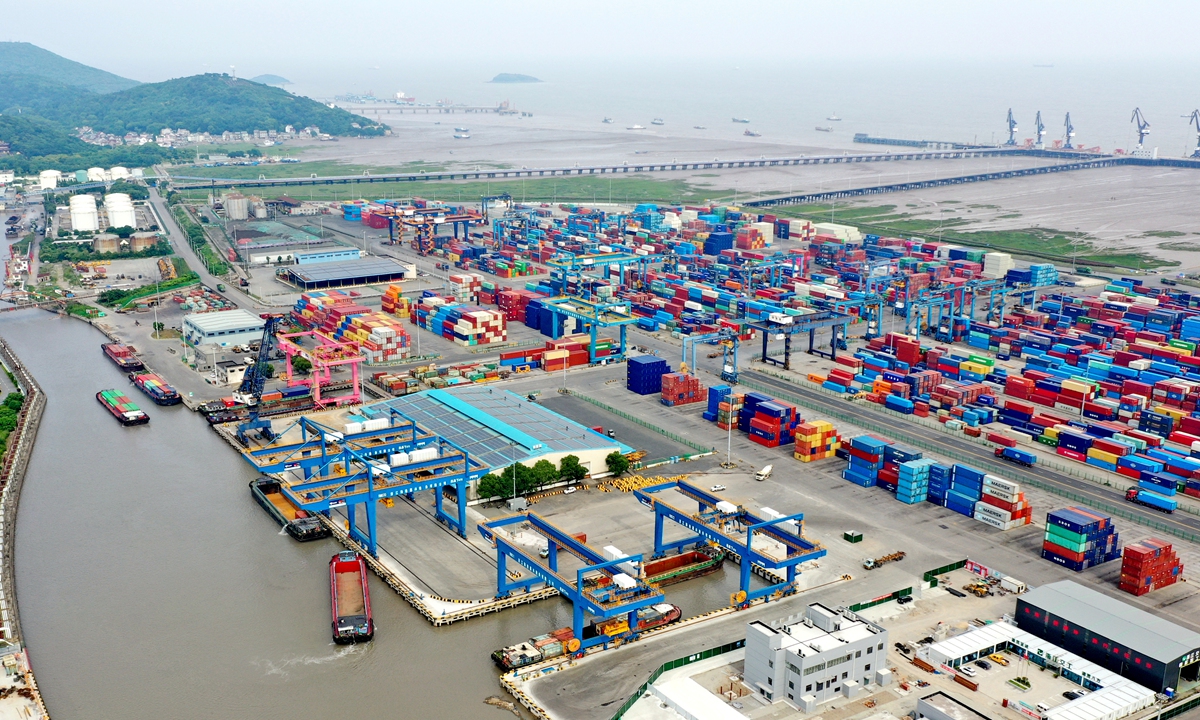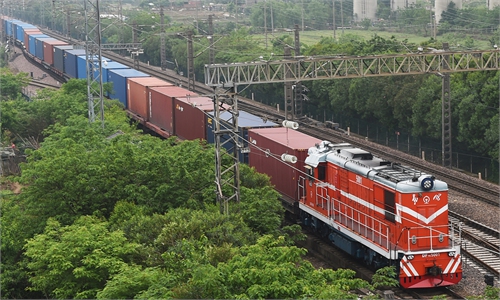China's foreign trade expands 16.6% in July, bucking slowdown fears
Strong growth shows resilience of nation's export machine: experts

Containers are loaded on barges at a port in Jiaxing, East China's Zhejiang Province on June 16, 2022. The throughput of containers that were shipped between oceangoing vessels and river-going vessels saw a sharp increase of 69.4 percent year-on-year during the first five months of 2022, according to Ningbo Zhoushan Port Group. Photo: Courtesy of Ningbo Zhoushan Port Group
China's foreign trade maintained double-digit growth in July at 16.6 percent year-on-year, official data showed on Sunday, underscoring the resilience of China's giant export machine and bucking market fears of a slowdown due to cooling global consumer demand amid high inflation as well as growing geopolitical uncertainties.
Experts noted that the strong performance of China's imports and exports will inject momentum into the country's economic recovery in the second half of the year, while easing market concerns over a global economic recession.
According to data released by the General Administration of Customs (GAC) on Sunday, the country's foreign trade totaled 3.81 trillion yuan ($563.5 billion) in July, an increase of 16.6 percent on a yearly basis.
In the first seven months, the country's foreign trade volume reached 23.6 trillion yuan, an increase of 10.4 percent year-on-year, faster than the growth rate of 9.4 percent seen in the first half of the year, according to the GAC.
"The better-than-expected data reflects that the pent-up growth momentum is being released throughout the year after the fallout of the COVID-19 resurgence in spring was overcome," Bai Ming, deputy director of the International Market Research Institute at the Chinese Academy of International Trade and Economic Cooperation, told the Global Times on Sunday.
Bai said that a raft of measures, including special relief for small and medium-sized enterprises and tax reductions, as well as the depreciation of the Chinese yuan and a significant drop in shipping costs, contributed to the accelerated growth in July.
The steady throughput growth among Chinese ports also underlies the sound rebound in the country's foreign trade sector. According to data from the China Ports and Harbours Association, the container throughput of eight coastal container hub ports increased by 12.7 percent year-on-year in July, while the Shanghai port and the Ningbo-Zhoushan port - two of the country's largest ports - saw their container throughput up 16.8 percent and 25 percent year-on-year, respectively.
Between January and July, China's trade with its top three trading partners - ASEAN, the EU, and the US - grew 13.2 percent, 8.9 percent, and 11.8 percent year-on-year, respectively. Trade with Belt and Road partners jumped 19.8 percent year-on-year, while that with the 14 Regional Comprehensive Economic Partnership (RCEP) economies was up 7.5 percent from January to July, according to the GAC.
The robust growth in China's trade with these countries and regions is a slap in the face to some Western media that have claimed that overseas demand for Chinese products will decline in the second half as the COVID-19 pandemic continues and major economies stall, experts noted.
In July, China's exports increased 23.9 percent year-on-year to 2.25 trillion yuan, while imports rose 7.4 percent year-on-year to 1.56 trillion yuan. The trade surplus expanded 90.9 percent year-on-year, hovering at a high level.
Zhou Maohua, a macroeconomic analyst at Everbright Bank, told the Global Times that domestic enterprises' imports are affected by high energy and commodity prices, as the domestic economy continues to recover, while global economic uncertainties are also affecting their confidence.
Tian Yun, a Beijing-based economist, told the Global Times on Sunday that the large trade surplus also indicates that the severity of global inflation and supply shortage caused by the Russia-Ukraine conflict, Western sanctions and the global supply chain restructuring has gone beyond expectations.
"If the trend continues, the foreign trade sector may drive up China's GDP growth rate by 1 percentage point," Tian said.
Looking ahead, Bai said that the possibility of the US lifting some tariffs imposed on Chinese exports and the dividends brought by the RCEP will continue to add momentum to China's foreign trade in the second half of the year.
However, rising uncertainties and challenges such as economic contraction in Europe and the US as well as rising competition from Southeast Asian countries like Vietnam could add pressure to China's exports, he said.
Amid the ongoing uncertainty, China will implement a series of measures to stabilize and improve the quality of foreign trade in the second half of the year to consolidate its resilience, Shu Jueting, a spokesperson for the Ministry of Commerce, said at a recent press briefing.
Officials will work to guide foreign trade firms to explore and expand the international market, and the country will continue to organize international exhibitions, such as the China International Import Expo and the China Import and Export Fair, and encourage localities and industrial associations to hold online exhibitions, she said.


